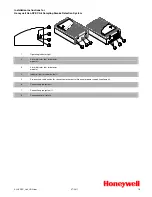
Page 7
NEVER use an open flame of any kind to test this smoke alarm. You might accidentally
damage or set fire to the smoke alarm or to your home. The built-in test switch accurately
tests the smoke alarm's operation as required by Underwriters Laboratories Inc. (UL).
(UTHA) Sensitivity Indicating Means.
TESTING:
Test by pressing the Test button on the smoke alarm cover until the alarm sounds,
then release. The alarm sounds if all electronic circuitry, horn and battery are working. If no alarm
sounds, the alarm may have a power supply failure.
Test the smoke alarm weekly to assure
proper operation. IMPORTANT:
Under normal conditions, the test button should sound the alarm
immediately after it is pressed. There are special conditions that, when you press the Test button,
you will experience a delay of approx. 10-15 seconds before the alarm sounds. This delay occurs
if the test button is pressed during a self-diagnostic period. This occurs: (1) Upon initial power
up; (2) After battery activation (and no AC power is present); (3) If 120 volt AC power has been
interrupted and no backup battery is present.
ALARM ORIGINATION:
QUICK FIND
®
Alarm Origination - In an interconnected system consisting
of any of these models: 5304, 5304L, MI106, MDS107, MCN108, MICN109, MDSCN111, MP117,
MI106S and MIC1509S, it may be difficult to determine which alarm initiated the alarms to sound
during an alarm event. This QUICK FIND
®
feature will immediately allow you to locate the originating
alarm once the alarms have stopped sounding. To initiate QUICK FIND
®
,
press the Test/Silence
button on any alarm. After releasing the button, the test sequence on this alarm will begin and
last 5-20 seconds, and then stop. The specific test sequence horn pattern is designated by the
alarm type. Once this test sequence ends, the originating alarm continues to sound for approx.
60 seconds, which provides ample time to locate the originating alarm. Remember to reset the
originating alarm in order to clear the QUICK FIND
®
alarm origination and to return your system to
normal operation. Refer to the wiring instructions model interconnect compatibility section of this
manual (Page 5) for additional information. In a non-interconnected installation, it is necessary to
test each alarm by pressing and releasing the Test/Silence button to determine the originating alarm.
RESET:
To reset the QUICK FIND
®
Alarm Origination condition, press and hold the Test
button on any alarm for at least 10 seconds and then release. Reset after each alarm. The
reset feature will reset all interconnected units.
END-OF-SERVICE LIFE NOTIFICATION:
A majority of home fire deaths are a result of no smoke
alarms or no
working
smoke alarms. In addition to the "replace by date" stamped on the back of
your alarm, your alarm contains a unique audible end-of-service life notification feature. When it
is time to replace your alarm, which is after approximately 10 years of operation from initial power
up, the alarm will sound 2 chirps approx. every 60 seconds and the red LED will blink on once
approx. every 2 minutes. The green LED stays on. The alarm should be replaced immediately.
IMPORTANT CONSIDERATIONS
YOUR ALARM HAS BEEN DESIGNED WITH A PRODUCT END-OF-SERVICE LIFE WARNING
WHICH WILL SOUND AFTER APPROXIMATELY 10 YEARS OF OPERATION FROM INITIAL
POWER UP.
NOTE: MANUFACTURER RECOMMENDS REPLACEMENT OF THIS ALARM 10 YEARS
AFTER DATE OF INSTALLATION. NOTE: NUMEROUS ALARMS OR PROLONGED ALARMING
IS NOT TYPICAL AND WILL CONSUME THE BATTERY CAPACITY, SHORTENING THE LIFE
OF THIS PRODUCT.
(UTHA) Sensitivity Indicating Means
The sensitivity indicating means for this Smoke and Fire Alarm is the use of the analyzer for
Smoke Detectors Model 501-A or 501-A/Bat Aerosol Generator manufactured by Gemini Scientific
Corp., 1122-B Aster Ave., Sunnyvale, CA 94086. The Equivalent UL 268 Light obscuration %/Ft
as measured by this instrument must be within the obscuration listed on the back of this alarm.
(UTHA) Go/No-Go Field Test
The Go/No-Go test for this smoke and fire alarm is to use one of the following UL listed can-type
aerosol smoke alarm testers. The instructions for use are printed on the canister. Home Safeguard,
Model 25S.





























